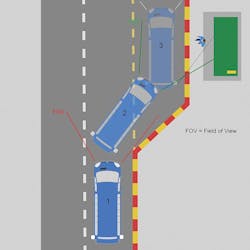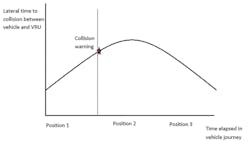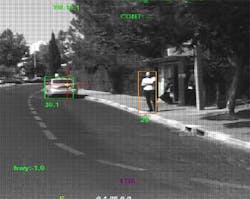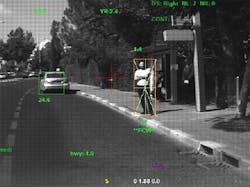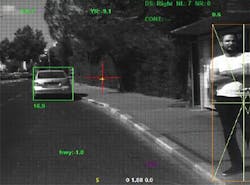Modern challenges
Imagine that you are a bus driver in today’s urban environment. You are surrounded by rushed and distracted drivers and pedestrians, cyclists riding in your blind spots, delivery trucks stopping suddenly in front of you, and challenging weather resulting in treacherous road conditions. At the same time, you are dealing with passenger questions, fares, traffic congestion and road construction. All the while, you are expected to keep your bus running on time. And even more importantly, you are responsible for the safety of both passengers on the bus and pedestrians outside of it.
Beyond the danger to human life, there is a lot on the line for bus drivers if a collision does occur. The bus driver may be injured, he may experience personal trauma, and his career may be disrupted. Beyond the impact on the driver, even minor collisions can disrupt a mass transit system and city traffic, and insurers are reporting that the most catastrophic collisions, such as pedestrian collisions and rear-end collisions, are becoming more costly.
Unfortunately, the number of collisions caused by buses and large trucks is going up, not down. Between 2002 and 2014, buses and vanpools in the U.S. were involved in 85,391 collisions, leading to 1,340 fatalities and 201,382 injuries. Between 2009 and 2015, the number of fatal crashes involving large trucks or buses increased by 20%, and the number of crashes leading to injuries increased by 62%.
Sobering statistics such as these have mass transit officials and regulatory bodies seeking new ways to lower the risk of collisions. Many are looking to advanced driver assistance systems (ADAS) to help reduce collisions by alerting drivers to danger in front of and around the bus. ADAS could cut collisions and have an impact on city expenditures for casualty and liability expenses resulting from bus and vanpool collisions, which from 2002-2013 exceeded more than $5.7 billion in the U.S.
However, until recently, engaging ADAS for mass transit buses was not an option. Unlike passenger vehicle manufacturers, bus manufacturers were not, and most still are not, offering integrated ADAS solutions for collision mitigation. In addition, transit buses tend to be on the road and stay in service for many years. Therefore, even if the manufacturers started offering integrated ADAS solutions for collision mitigation on new buses tomorrow, it could still be years before such buses would be widely deployed. This means that an ADAS solution for mass transit would have to be designed as a retrofitable, aftermarket product, tailored to meet the specific needs of buses already on the road.
Tailoring ADAS for large municipal vehicles, such as buses, is not as simple as adapting existing forward-facing collision avoidance technology for cars to fit a larger vehicle. Rather, the geometry of a bus is different than that of a passenger vehicle, resulting in driving dynamics that present unique types of dangerous situations—situations very different from the regular daily commute in our cars.
Perilous situations faced by bus drivers include:
- Pedestrians or cyclists in blind spots. Buses have large blind spots on both sides of the vehicle and by the A-pillar, which can completely conceal pedestrians and bicyclists from the driver’s sight;
- Making a left or right turn. Buses have greater turn radii while navigating the same-size junctions as cars;
- Approaching a bus stop. Buses often approach bus stops crowded with people, while also continuing to move; and
- People running alongside or even rushing in front of the bus in order to catch the driver’s attention (even at risk to themselves).
So, when Mobileye began redesigning its standard car technology for mass transit, it focused on how to deal with the unique challenges presented in these types of dangerous scenarios. For example, in the case of the bus-stop approach: A typical driver-assist system would alert a driver when the time-to-collision with a pedestrian becomes critically low, but here the bus is supposed to get close to the pedestrians as it pulls into a crowded bus stop. If the system rang a pedestrian alert every time a bus approached a stop, the driver would start to ignore it. So correct calibration is essential.
Beyond addressing such unique scenarios faced by bus drivers, several other challenges cropped up in designing a retrofit solution. Installation had to be relatively quick, as having a bus out of service for an unreasonable length of time would be very disruptive to a transit system and its riders. And since this would necessarily be a retrofit solution, it had to be capable of being installed on many different vehicle models and vehicles of varying ages.
The resulting product, Shield+, was designed to meet all of these challenges.
From April to June of 2016, 38 system-equipped buses logged 35,129 miles, 16,600 hours of video and 10,000 events.
The WSTIP-ping point
One grouping that wanted to go beyond their existing systems and practices, and actually test ADAS on transit buses, was the Washington State Transit Insurance Pool (WSTIP), an insurance pool consisting of 25 Washington State public transit agencies.
Understanding the human and financial impact of collisions, Jerry Spears, former deputy director of WSTIP, knew it was time to try something new. “In early 2013 we recognized that our most expensive and catastrophic loss-drivers were pedestrian strikes and rear-ender accidents,” Spears said, “and they were only getting more costly and devastating. We needed a new approach to address these catastrophic loss-drivers. Seeing collision avoidance systems [operating] in cars made us believe that this technology could be applied to transit vehicles. We were confident that the introduction of collision avoidance technology would dramatically reduce the misery index when transit vehicles are involved in an accident. Funds that are normally used for accident mitigation could then be repurposed for more constructive uses, like expanding transit services or facilities.”
In 2016 WSTIP won a grant from the Transportation Research Board’s (TRB) Innovation Deserving Exploratory Analysis (IDEA) Program to launch a pilot and research study. Backed by additional funding from WSTIP, Alliant Insurance Services Inc., Government Entities Mutual Inc., Pacific Northwest Transportation Consortium (PacTrans) and Munich Re America Inc., WSTIP equipped 38 buses with a retrofitted ADAS. The WSTIP study was the first-ever statewide effort to test collision warning systems in a wide range of urban, suburban and rural operating environments.
The retrofitted ADAS system that WSTIP tested uses outward-facing vision sensors placed inside and outside the bus. Monitoring the road ahead, and the blind spots along the A-Pillar/left mirror and the sides of the vehicles, the system analyzes the risk of collision with vehicles, pedestrians and cyclists in front, pedestrians and cyclists in the blind spots, unintended lane departures, and headway/following times. When a threat is detected, the system warns the bus operator with visual and audio alerts. These alerts are designed to give drivers time to avoid, or at least mitigate, a collision.
The WSTIP study was the first-ever statewide effort to test collision warning systems in a wide range of urban, suburban and rural operating environments.
Seeing results
Several different research methods were used to test the retrofitted ADAS. During the official data collection period of April 1, 2016, through June 30, 2016, the 38 system-equipped buses logged 352,129 miles and 23,798 operating hours, 277 driver surveys were returned, and 16,600 hours of video and 10,000 events were logged. One transit agency operated its system-equipped buses in “stealth mode,” meaning the system was active and recorded when alerts would have appeared/sounded, but such alerts were not actually broadcasted to the drivers. That group of buses served as the control group.
The University of Washington research team also looked at the rate of false positives and false negatives by comparing the retrofitted ADAS alert data to video footage recorded at the time of the alert. To explore how the actual reduction of warnings could affect the loss analysis and liability claims, the WSTIP team, led by Dr. Jerome Lutin and Dr. Yinhai Wang, who served as co-principal investigators, put their claims into three groups to study: Claims not affected by ADAS (e.g., when a passenger would slip and fall); vehicular claims that can be affected; and pedestrian claims that can be affected.
The study’s findings were released in a paper in July 2018. Those findings included:
- Buses with the retrofitted ADAS experienced 71.55% fewer forward collision warnings per 1,000 miles, when compared to the control group;
- Buses with the retroffited ADAS experienced 43.32% fewer pedestrian and cyclist collision warnings and blind spot warnings per 1,000 miles, when compared to the control group;
- The accuracy rate of the system was found to be around 96%, meaning that 96% of alerts accurately warned of a potential collision. (The remaining ~4% of alerts were “false positives.”) This is important, because a high rate of false alerts could potentially result in drivers beginning to assume alerts are generally false and paying less attention to them. (In addition, the study assessed that occasions when the retrofitted ADAS failed to warn when it ought to have were 0.3%, i.e., a negligible amount.);
- No retrofitted ADAS-equipped buses were involved in any rear-end collisions or collisions with pedestrians or cyclists during the pilot; and
- The system “rarely missed potential conflicts” and “was found to be robust in challenging situations, such as adverse weather, low lighting, direct sunlight and shadows.”
Dr. Lutin found the results encouraging and summarized them this way: “We found that had the collision avoidance systems been in use over the 13-year historical period for which we had claims data, the estimated annual net savings per bus would have ranged from $904 to $1,947.”
The study also answered one of the biggest questions WSTIP had going into the research: Could ADAS reduce the cost of vehicular and pedestrian claims? Indeed, the study found that buses equipped with the system experienced a 58.5% potential reduction in vehicular and pedestrian collision claims (by value) compared to the larger pool of buses insured by WSTIP.
This study finding is of special interest to insurers. “Munich Re is committed to saving lives, reducing injuries and minimizing losses in the public transportation sector,” Mike Scrudato, senior vice president of new strategic markets and leader of the Mobility Domain, at Munich Reinsurance America Inc., said in reaction to the WSTIP study. “Proactively adding a collision avoidance system to a transit agency’s risk management program for its fleets can help mitigate crashes and improve safety in the near-term, rather than waiting for collision avoidance equipment to become standard on new buses, which could take 12-18 years based on the minimum expected life of a transit bus.”
Perhaps one of the biggest indications of the strength of the data and the beneficial impact ADAS could have in decreasing the number of collisions and their associated liability costs was that Pierce Transit, one of the WSTIP members participating in the study, seven of whose buses had been fitted with the retrofitted ADAS for the pilot, decided to immediately retrofit its entire fleet of 176 40-ft transit buses with collision avoidance warning systems. In addition, Pierce Transit will extend research and data collection for another full year.
Since buses often approach bus stops, correct calibration for warning systems is crucial for determing the actual risk of a collision with a pedestrian.
Transit buses as smart city agents
More and more transit authorities across North America are actively deploying or piloting ADAS systems in their buses.
In addition to the benefits set out above which were studied by WSTIP, many collision avoidance systems also can be interfaced with fleet management systems (FMS) which collect various data crucial for transit officials, city officials and state DOTs. Already today, ADAS can be leveraged to pinpoint potential danger zones along bus routes, allowing officials the opportunity to make proactive repairs or improvements to city infrastructure, such as in the cases of poorly designed intersections, unmarked or insufficiently marked lanes, or dangerous potholes. Cities can save millions of dollars by not only reducing the direct costs of collisions, but by using their city vehicles as smart agents to harvest information about the condition of their city’s streets.
Distracted drivers and pedestrians will continue to be a fact of life, congestion will continue to grow, bus drivers will continue to face dangerous scenarios and stressful environments, and infrastructure will need to address the ever-changing urban landscape with more people and more vehicles. ADAS technology, including data collection and reporting, can be a critical tool for any city trying to improve safety for its citizens. And in improving safety, this technology also can aid in lowering the costs associated with collisions, both human and financial. Best of all, no city needs to wait for some futuristic solution to better their transit system. The technology exists today. Lives can be saved starting today. Even the bottom line can start improving today.



